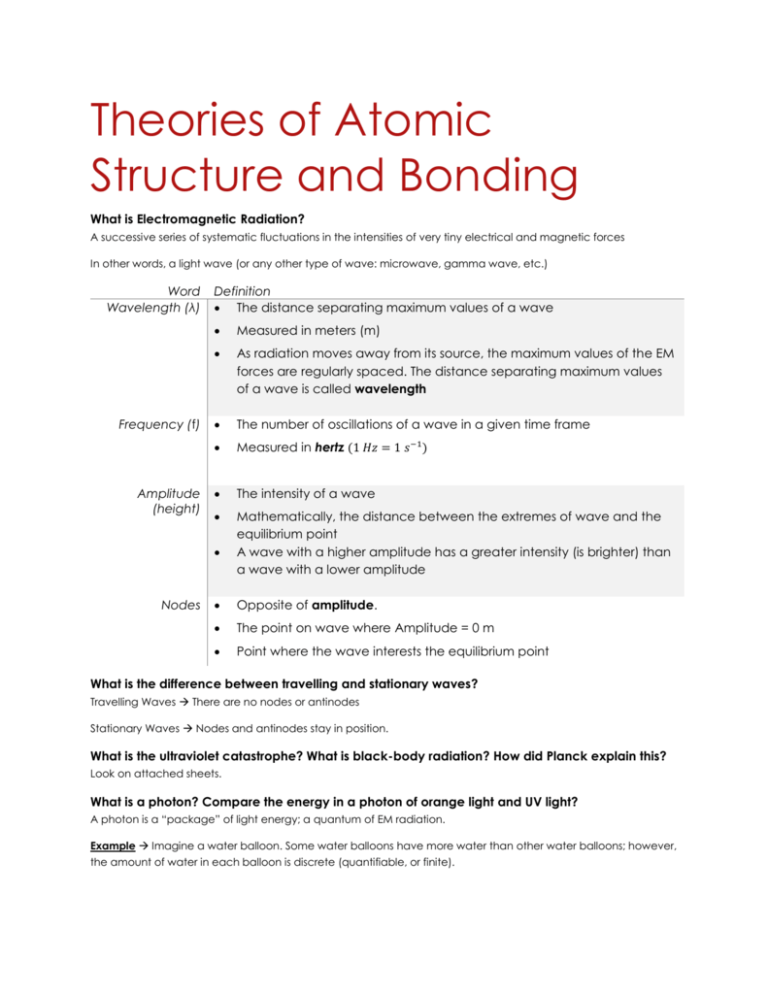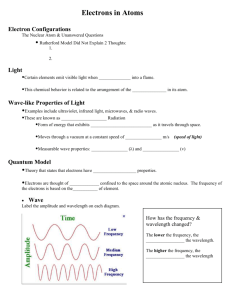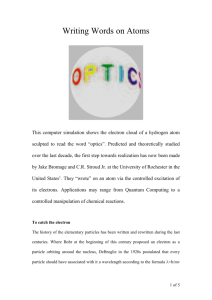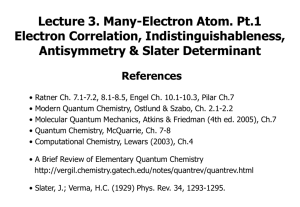File - ChemBlog Inc
advertisement

Theories of Atomic Structure and Bonding What is Electromagnetic Radiation? A successive series of systematic fluctuations in the intensities of very tiny electrical and magnetic forces In other words, a light wave (or any other type of wave: microwave, gamma wave, etc.) Word Wavelength (λ) Frequency (f) Amplitude (height) Definition The distance separating maximum values of a wave Measured in meters (m) As radiation moves away from its source, the maximum values of the EM forces are regularly spaced. The distance separating maximum values of a wave is called wavelength The number of oscillations of a wave in a given time frame Measured in hertz (1 𝐻𝑧 = 1 𝑠 −1 ) The intensity of a wave Mathematically, the distance between the extremes of wave and the equilibrium point A wave with a higher amplitude has a greater intensity (is brighter) than a wave with a lower amplitude Nodes Opposite of amplitude. The point on wave where Amplitude = 0 m Point where the wave interests the equilibrium point What is the difference between travelling and stationary waves? Travelling Waves There are no nodes or antinodes Stationary Waves Nodes and antinodes stay in position. What is the ultraviolet catastrophe? What is black-body radiation? How did Planck explain this? Look on attached sheets. What is a photon? Compare the energy in a photon of orange light and UV light? A photon is a “package” of light energy; a quantum of EM radiation. Example Imagine a water balloon. Some water balloons have more water than other water balloons; however, the amount of water in each balloon is discrete (quantifiable, or finite). Energy of orange light = 640nm Energy of UV light = 400nm Word Emission Spectrum Spectroscopes Definition The release of colored line spectra when atoms in an excited state emit photons as they fall to a lower energy level (from n=2 to n=1) A tool used to form the basis of an analytic method called spectroscopy (a technique for analyzing spectra; the spectra may be visible light, infrared, UV or X-Ray) Bright-Line Spectrum A series of bright lines of light produced or emitted by a gas excited by energy Absorption Spectrum Related to an atom’s emission spectrum Results when electrons absorb photons of certain wavelengths, and so are excited from lower energy levels to higher energy levels What were the models of Thomson and Rutherford? What were the problems with these models? Thomson After discovering the electron in 1897, Thomson proposed his version of the atomic model: a positively charged sphere embedded with sufficient number of electrons to balance (neutralize) the total charge. Since the proton had yet to be discovered, Thomson opted to give the entire sphere a uniform, positive charge. Problem Upon the discovery of protons, the entire model became useless. Also didn’t account for energy levels, the movement of electrons, etc. Rutherford Rutherford’s model of the atom was the most in-depth and most detailed model of his time. Rutherford proposed that: “An atom is composed of a very tiny nucleus, which contains positive charges and most of the mass of the atom. Very small negative electrons occupy most of the volume of the atom. For the most part, the atom is an empty place.” Problem an atomic nucleus composed entirely of positive charges should fly apart due to electrostatic forces of repulsion. Rutherford’s nuclear atom couldn’t adequately explain the total mass of the atom. Bohr’s Contributions to Quantum Theory Bohr’s Atomic Theory Electrons travel in circular orbits with quantized energy – energy is restricted to only certain discrete quantities. There is a maximum number of electrons allowed in each orbit. Electrons move from energy level to energy level depending on the stimuli (i.e. e- could “jump” from n=1 to n=2 after absorbing a photon of energy. A photon is emitted as the electron “drops” to a lower level, n=2 to n=1) Scientists Louis de Broglie Werner Heisenberg Erwin Schrodinger Contributions Dual nature of light (matter and waves) Dual nature of matter (electrons are matter waves) Uncertainty Principle cannot know the location and the velocity at the same time General Wave Equation Schrodinger’s Cat What are the 4 Quantum Numbers? 1. n principal quantum number (energy levels: n =1 ∞) 2. l angular momentum quantum number [l = 0 (s), 1 (p), 2 (d), 3 (f)] 3. ml magnetic quantum number; specifies the orbital if l = 0; ml = 0 (“s” orbital) if l = 1; ml = [-1, 1] (“p” orbital) 4. ms magnetic spin Clockwise +½ Anti-Clockwise -½ What is the evidence that electrons have two directions of spin? 1. The Pauli Exclusion Principle: no two particles can occupy the same quantum state at the same time. So if you have two electrons in the same orbital, they can't have the same spin, or else everything about them would be the same. Its basis is in the fact that all quantum objects are unique. If 2 quantum objects (electrons) were in the same orbital with the same spin, you would no longer be able to distinguish them from each other, which would violate this uniqueness principle. As for the ½, it was derived from the Stern-Gerlach experiment, where an electron beam was passed through a magnetic field and the beam split into 2 halves. One half of the electrons go up and the other half go down. So the probability of seeing an electron with spin up is ½ and the same for the electron with spin down. 2. An electron spin s = ½ is an intrinsic property of electrons. Electrons have intrinsic angular momentum characterized by quantum number ½. “Two types of experimental evidence which arose in the 1920s suggested an additional property of the electron. One was the closely spaced splitting of the hydrogen spectral lines, called fine structure. The other was the Stern-Gerlach experiment which showed in 1922 that a beam of silver atoms directed through an inhomogeneous magnetic field would be forced into two beams. Both of these experimental situations were consistent with the possession of an intrinsic angular momentum and a magnetic moment by individual electrons. Classically this could occur if the electron were a spinning ball of charge, and this property was called electron spin.” http://hyperphysics.phy-astr.gsu.edu/Hbase/spin.html http://web.clark.edu/nfattaleh/classes/141_151/LectureNotes/141TroCh8.pdf









